 Children's book illustrations are enjoyed by all who appreciate simple yet ingenious representations of the world around us. Simple representation does not mean there is no underlying sophisticated idea, as these appealingly humorous illustrations contain intricate detail and are often wonderfully educational. (pic...In Fairyland, after a feast)
Children's book illustrations are enjoyed by all who appreciate simple yet ingenious representations of the world around us. Simple representation does not mean there is no underlying sophisticated idea, as these appealingly humorous illustrations contain intricate detail and are often wonderfully educational. (pic...In Fairyland, after a feast)
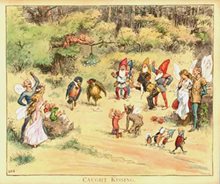 Over a hundred years ago, a story-teller's words were illustrated by an artist. Illustrations were usually inserted between pages of simple graphically-described stories or poems. Today, few illustrations remain in good condition as book spines deteriorated from poor handling. Brightly-coloured full-page illustrations for books of larger format were the most 'appreciated' (most frequently handled) - and these illustrations usually became loose and/or damaged. Enthusiastic young children frequently drew (scribbled!) with coloured pencils over illustrations, or even tore the pictures out. More than with any other antique print subject, we are lucky any survived! (pic...Birds Caught Kissing - Gnomes, Fairies, Elves & Insects)
Over a hundred years ago, a story-teller's words were illustrated by an artist. Illustrations were usually inserted between pages of simple graphically-described stories or poems. Today, few illustrations remain in good condition as book spines deteriorated from poor handling. Brightly-coloured full-page illustrations for books of larger format were the most 'appreciated' (most frequently handled) - and these illustrations usually became loose and/or damaged. Enthusiastic young children frequently drew (scribbled!) with coloured pencils over illustrations, or even tore the pictures out. More than with any other antique print subject, we are lucky any survived! (pic...Birds Caught Kissing - Gnomes, Fairies, Elves & Insects)
For youngest children
I am told that very young eyes focus first on outlines of shapes. Chloe Preston's clearly outlined, brightly coloured lithographs on white backgrounds, show the Peek-a-Boo family's outings and mishaps - described by Chloe's brother, Tom Preston.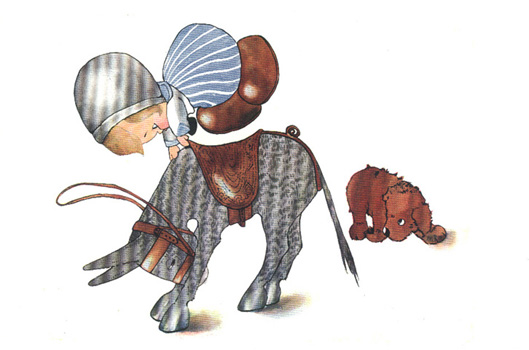
Enjoyed by young and old alike, the four Peek-a-Boo children rode donkeys and goats, and had a puppy named Gingerbread whose expression and behaviour responds perfectly to each situation when he accompanies his family through all their adventures. The illustrations provoke spontaneous laughter as well as suspense, and are great lessons for life's challenges - and how to handle them. (pic...Puppy, and Peek-a-Boo hanging on to Donkey)
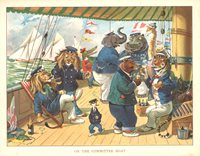 Personified nature
Personified nature
Illustrations of nature are popular with all ages. Some of the most entertaining we have are G.H. Thompson's lithographs for a regatta in animal land. The very important regatta committee animals party on the committee boat - oblivious of the animal participants and watchers. Ernest Nister moved from Germany and established himself as a printer in London in 1888. Around the turn of the century he specialized in high quality printing of children's books. Thompson began doing watercolours for Nister, then he did coloured lithographs for printing. Thompson's portrayals of personified animals with distinctly human characteristics, show their individuality and attitudes in each situation, even following the fashions of the day. (pic...Animal Regatta Committee Boat.)
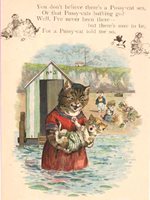 There are also wonderful portraits of animals in Weedon's lithographs for The Little People's Book of Fun by L.L. Weedon and Clifton Bingham - also printed in colour c1910 by Ernest Nister.
There are also wonderful portraits of animals in Weedon's lithographs for The Little People's Book of Fun by L.L. Weedon and Clifton Bingham - also printed in colour c1910 by Ernest Nister. 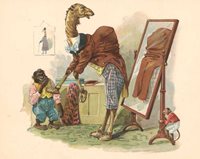 Who wouldn't smile at the sight of a camel wearing a bow tie, trying to see his back in a mirror while being fitted (with difficulty) for a new tuxedo jacket - with a monkey as his tailor, holding scissors?... or a full-page illustration of notoriously shy of water "Pussy-cats", playing on their own Pussy-cats' Beach - and wading in the water. (pics... A Beach for Pussy-cats, and Camel-Coat..)
Who wouldn't smile at the sight of a camel wearing a bow tie, trying to see his back in a mirror while being fitted (with difficulty) for a new tuxedo jacket - with a monkey as his tailor, holding scissors?... or a full-page illustration of notoriously shy of water "Pussy-cats", playing on their own Pussy-cats' Beach - and wading in the water. (pics... A Beach for Pussy-cats, and Camel-Coat..)
Forest whimsy
Children's illustrations often stand out simply against a plain background; but rather appropriately, with fairies, elves, gnomes and other forest creatures, there is simply delifhtful subtle detail, all over the page. 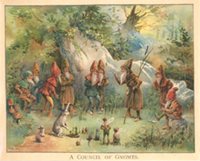 For Richard Doyle's In Fairy-Land the exquisite lithographs and coloured engravings by Edmund Evans all tell a story, with activities and problems being solved... as are E. Stuart Hardy's (Beatrice Evelyn Elizabeth Hardy's) imaginative lithographs and woodcuts for Fred E. Weatherley's The Book of Gnomes.
For Richard Doyle's In Fairy-Land the exquisite lithographs and coloured engravings by Edmund Evans all tell a story, with activities and problems being solved... as are E. Stuart Hardy's (Beatrice Evelyn Elizabeth Hardy's) imaginative lithographs and woodcuts for Fred E. Weatherley's The Book of Gnomes.
When printing costs did not extend to contemporary colour for all illustrations we frequently find some images have been hand-coloured since publication. Quality colouring adds enormously to the enjoyment and value of these antique prints for the young at heart. (pics...Council of Gnomes and other forest life, and After the Picnic. Elves and Friends tidying up.) 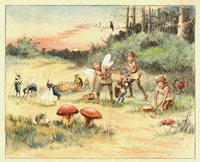
With stories absent, it is inevitably a temptation to use our own imagination to conjure a story. Ask a young child - or older sibling - what they each think might be going on in a picture. You'll be surprised what their vivid imaginations come up with - and their increased creativity when challenged with creating a different story that might also suit. Good quality 'children's illustrations' are enjoyable involuntary education for children - and can be appreciated by all.